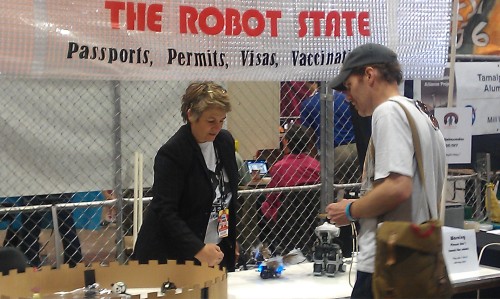Maker Faire 2011 was on May 21-22 and I attended to try out a fun way of continuing conversations about robots as assistant to the Robot Ambassador. CNET’s Daniel Terdiman wrote a great Maker Faire overview including me.
As this project evolves, I intend to extend the interactive robot ambassador and its ‘pets’ or workers, using robots with features both appealing and disconcerting to explore the meaning that people make of what a robot is.
One project that was attracting a lot of kids was Andra Keay’s The Robot State. This is part of Keay’s thesis project, which is a study of playing with robots and what doing so means.
Kids were swarming to her booth, where Keay was processing “applications” for the Robot State. She would ask them three questions: what are the names of three different robots you know of; what are robots’ biggest achievements; and how do you see yourself in the future of human-robot relations.
Keay explained that most people answer the first query with the names of fictional robots and that the question usually throws people off so much, they don’t even know how to respond to the second. But ultimately, she said, her work is about trying to discover some of the truths that lie in human-robot interactions. One thing she said she’s noted in her research is that just about anyone who builds a robot names it, even if their projects are not about social robots. “We like names,” she said. “You want to work on something. We like naming things.” She wants to study the stories behind the names people give their robots.The robots for this project were cobbled together very quickly due to thesis finishing and house moving (to USA) but were much more successful than hoped and a lot of fun. I am making a page for each robot and have rearranged the Robot State website to include more practical information. There will be more playing with robots in the future!
RoBird and the Ambassador
Friday, May 27, 2011
Robot State at Maker Faire | The Robot State
Friday, May 6, 2011
Hang up the iPhone, here comes paper phone
Hang up the iPhone, here comes paper phone
Flexible device will allow users to make calls and play games
By GILLIAN SHAW, Vancouver Sun May 4, 2011Move over, iPhone; you soon could be replaced by the paper smartphone.
That’s the prediction from Prof. Roel Vertegaal, director of Queen’s University’s Human Media Lab, who will be presenting an interactive paper computer that duplicates many of the functions of an iPhone — from making calls to playing music to sharing books — at the Association of Computing Machinery’s CHI conference next week in Vancouver.
“We expect all phones to be like this within five to 10 years,” said Vertegaal.
What he’s calling the world’s first paper phone has the look and feel of a small sheet of translucent paper.
Vertegaal likens its look and form to a flexible conference badge, but the prototype phone can carry out computer functions, from playing music to making calls.
“The e ink screen is similar to what you find in the Kindle except this screen is flexible,” Vertegaal said of the 9.5-cm diagonal, thin-film flexible display screen that uses the technology found in ereaders like Amazon’s Kindle.
To make a call on the prototype phone, you squeeze the interactive paper, which has a layer that senses how it is being bent, and hold it to your ear.
“Just curving the screen, it knows you want to make a phone call,” said Vertegaal.
He said the intent of the prototype is to demonstrate what can be done with the technology. “This is very early days,” he said. “This is, as far as I am aware, the first paper phone.”
The team that created the prototype included researchers from Arizona State University as well as from Queen’s, working with ASU’s Flexible Display Center and the E Ink Corporation, a leading developer of electronic paper display technology.
The team’s presentation to the conference focuses on how the device’s functions can be controlled by bending the display in various ways.
Vertegaal said the prototype has limited functionality and it would cost hundreds of millions of dollars to take the idea through commercialization.
The prototype offers a peek at a new generation of super-thin and flexible computers that are more like paper than clunky laptops. Instead of windows on a computer screen, we’ll have pieces of electronic paper we can write on, send off the email and stack up, like sheets of paper. “This is going to change everything,” said Vertegaal. “It is going to change the way we work with computers.”
gshaw@vancouversun.com
© Copyright (c) The Vancouver Sun
via vancouversun.com
Another 'no more stacks of paper' - this will change everything? While I look forward to the technology (and think many new things will come of it), I don't see it replacing the piles of notes and books surrounding my computer. Just organising it better perhaps. At worst, adding to it! All the same, I wish I was going to Association of Computing Machinery’s CHI next week.Wednesday, May 4, 2011
Festival de robotique

Oh to be in Switzerland again! The Festival de Robotique on May 7 looks extremely full of robot goodness for all the family. There are 30 expositions, 21 workshops, 1 competition, 2 performance/demo/spectacles and you get a free Superpattt. The program is very interesting.
Subscribe to:
Posts (Atom)


